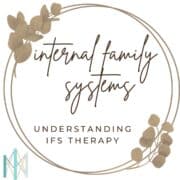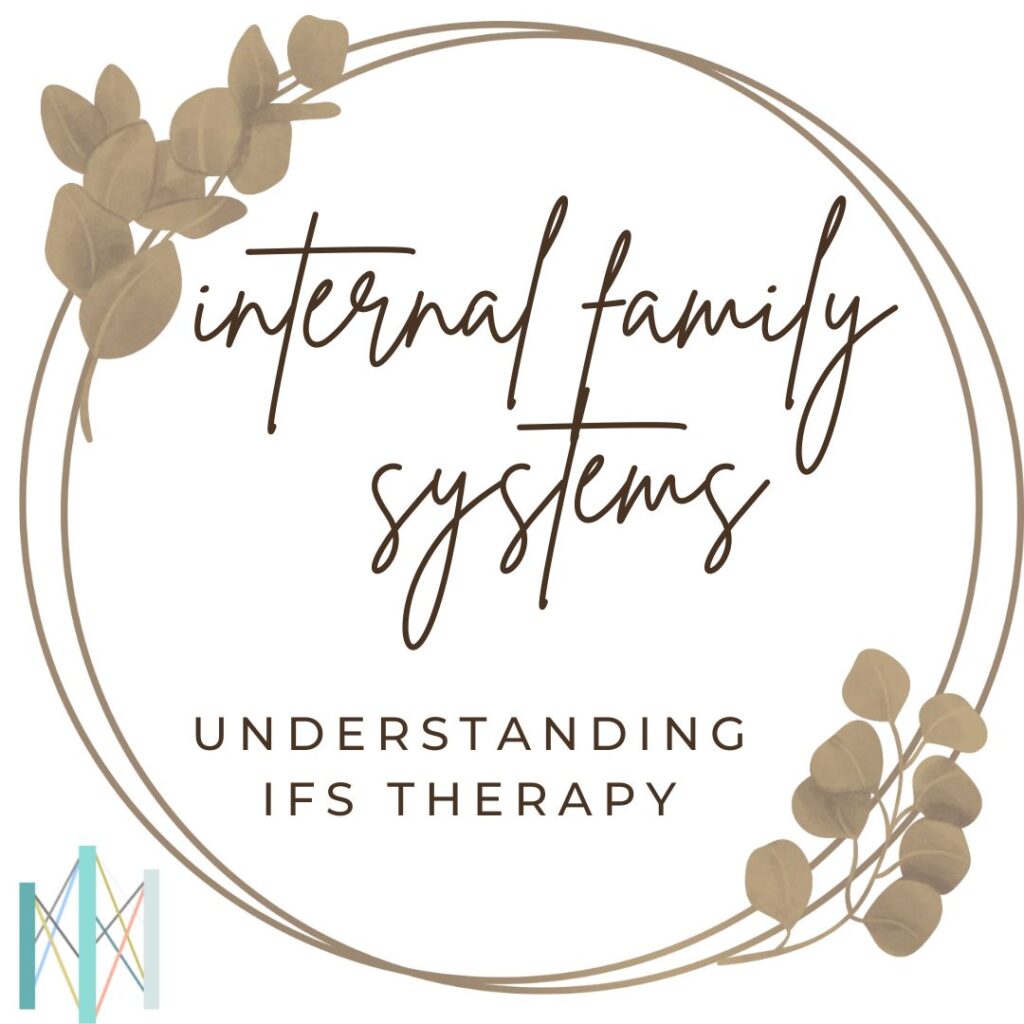
This month, our featured associate is Elizabeth Dausch. One of her primary modalities is Internal Family Systems Therapy (IFS), and in this blog, she offers an insightful introduction to how it works and why it matters. You can also learn more about Elizabeth from our Conversations with Clinicians Interview.

As a therapist, I’m continually struck by how many tools and approaches there are to support my clients. The vast scope of that toolbox can feel a little overwhelming at times. It’s easy to get lost in an alphabet soup: CBT, EMDR, ACT, AEDP, SE, the list goes on. What the heck do they all stand for and which one to choose?!
At the same time, I do appreciate that there are many options. No two people are the same, and different styles will speak to different people. Some approaches are better suited to certain issues than others. And many of them can be paired together and integrated really creatively.
As a practitioner, one of the approaches that deeply resonates with me is IFS or Internal Family Systems. I can get behind it so easily because it’s made the biggest difference in my own healing journey and for many of my clients. In recent years, it’s gained a lot of traction in the therapy world and wider culture. For example, the Inside Out films are loosely based on the IFS framework. If you’ve heard it referenced, wondered what all the fuss is about, or are interested in exploring it, I hope this blog will shed some light on it and what makes it unique.
What Is IFS Therapy and How Does It Work?
IFS is an evidence-based psychotherapy model developed by Richard Schwartz in the 1980s. It sees the mind as naturally multiple—meaning: we have many sub-personalities or parts that make up who we are. As the poet Walt Whitman put it, “Do I contradict myself? Very well then I contradict myself, I am large, I contain multitudes.” We often express this concept in everyday speech: “a part of me feels this, but another part of me feels that.” You may have parts who hold artistic energy, intellectual capacities, activist zeal, and many other naturally valuable qualities and talents. Parts who come forward in various roles as an employee, parent, athlete, etc.
But few of us get through life without some kind of wounding or trauma. We usually have parts who carry painful experiences from the past. It’s as if they’re frozen in time with their unmet needs, feelings, and beliefs.
We also have parts that take on subtle and extreme roles on behalf of the vulnerable ones. These protective parts might compel you toward perfectionism, self-criticism, overworking, people pleasing, numbing out, eating or drinking too much. Parts that take on harmful messages from society about race, gender, the body, sexuality, etc. Parts who remain loyal to familial patterns. And much of this develops without our conscious awareness.
Instead of eliminating the mixed feelings and inevitable conflicts among these parts, IFS sees them as something to explore, understand, and attend to.
Transformational healing occurs as a result of getting to know these parts and helping them release the burdens they’ve been carrying.
What’s the driving force behind all this? Your deepest Self, an inner well of qualities like compassion, curiosity, and calm. It doesn’t matter what you call it—some use terms like wise self, soul, source, or core. This Self is always present and can never be damaged. It is not a part, but rather has the ability to relate to parts. You can picture Self as the sun and parts as weather systems. The sun is always there and vital, but we may not see it or feel its warmth when a storm or thick clouds are passing through.
Therapy can help you gain greater access to Self and build the connection between this Self and your parts—inner relationships that last long after therapy ends.
A lot of people report that, after doing this work, there’s more space and energy available to pursue new things. There’s a greater sense of internal peace and integration, having recovered important parts that were cut off for so long. They feel way less activated and overwhelmed by the things that used to set them off. They know how to tend to the parts involved or treat the tension as a trailhead toward something needing attention.
A lot of people report that, after doing this work, they see themselves differently. There’s more space and energy available to pursue new things. They feel way less activated and overwhelmed by the things that used to set them off. And there’s a greater sense of peace and wholeness (having recovered important parts that were cut off for so long).
Are there parts that everyone has?
Every person’s internal world is different, but there are some commonalities.
Exiles: These are wounded parts of us who hold painful emotions and memories usually from childhood. They carry burdens like shame, fear, or grief and are usually “exiled” from our consciousness most of the time.
Managers: These parts are proactive protectors. They work hard to prevent the pain of exiled parts getting evoked in our lives. Some examples include an inner critic, people-pleaser, or parts that keep you very busy.
Firefighters: These parts are reactive protectors. They jump in when the pain of exiled parts have already been triggered and it feels overwhelming. They put out the emotional “fire.” Common examples include distraction or numbing behaviors (such as binge-watching TV, emotional eating, or substance abuse).
These types of parts are connected to each other and sometimes get stuck in cycles that create suffering. There are many moments when we feel completely taken over or “blended” with a part. A particular part might run the show so much of the time that you think “that’s not a part, it’s just me.” From an IFS perspective, it’s true that it is you, but not all of you. The one you’re focusing on can be understood as just a dominant part of you.
The goal of IFS therapy is not to fight against or get rid of these parts, but to help them heal, find healthier roles in your system, and to trust Self to lead in life.
What Differentiates IFS from other therapies?
Non-Pathologizing
Influenced by the medical model, mental health struggles can often be treated as illness, dysfunctional, or something that’s “wrong” with a person. By contrast, IFS assumes that all parts of us have a good and healthy intention—even if their strategies produce painful consequences. I’ve witnessed and personally experienced how radically healing it is to embody this attitude. It also shifts the focus from simply eradicating symptoms to working at the root level (which more effectively addresses the symptoms anyway).
Holistic
I would describe IFS as a “whole-person” approach. It looks at one’s thinking and behaviors but also includes other essential aspects of your experience and intelligence like emotions, the body, and intuition.
Internal Dialogue
IFS invites you to actively engage and directly contact these internal parts, rather than just talking about them (which is a place some therapies can stall out). It’s about creating a new experience inside with these parts.
Primacy of Self
Some models rely heavily on therapist interpretation and direction, but IFS empowers clients to access their own inner wisdom. It believes that every person has Self inside, which can be accessed for healing and cannot be destroyed.
However, this doesn’t mean the therapist is passive. They are a skilled guide in this process, just not “the healer.” It also sees the client’s relationship with the therapist as valuable in the therapy, but ultimately secondary to the client’s internal Self–parts connection. If you’re familiar with attachment theory, it looks at Self as the most important and lifelong attachment figure for your parts.
Benefits of IFS
Simply put, I’ve found that IFS has a way of taking you pretty deep pretty quickly. Of course, it takes time to build trust in any therapeutic relationship, and you’re never pressured to go anywhere or any faster than you’re ready for. But, many people have been surprised at what they learned and got to experience even within the first few sessions of trying it out.
IFS has been recognized for its effectiveness in treating a variety of mental health concerns, including trauma and PTSD, anxiety, depression, and addictions. By gradually working with parts rather than against them, clients often find that their symptoms gradually shift without force. Many people see improvement in their relationships as well.
In the past, you may have felt like you were playing “whack-a mole” with troubling behaviors or patterns—you manage one thing for awhile only to have a different one pop up somewhere else in your life. IFS can not only help resolve symptoms but more importantly, transform and heal the parts themselves who have been using symptoms as protective strategies. This creates lasting changes in your inner system instead of temporary relief: more integration, wholeness, and emotional resilience.
Another benefit? You don’t have to be in therapy forever! You can always come back to do targeted exploration. But this model incrementally equips you with the skills to work with your own system and make it a life practice if you want.
Limitations of IFS
Of course, IFS is not a perfect fit for every situation. It’s not recommended for severe conditions with psychosis or paranoia, such as schizophrenia. It’s not appropriate to use when someone is in an actively unsafe situation or their essential needs are going unmet (like food and shelter). Those things must be addressed first and stabilized. It’s not the best treatment option for someone with a TBI (traumatic brain injury).
IFS also depends on some degree of openness to an experiential approach. This usually entails paying attention to and connecting with your body, what’s happening internally in the moment, and listening inside. There will be room to talk together and look at mental processes, and a therapist will sometimes invite hardworking analytical parts to relax in the therapy. When there’s a preference for cognitive problem-solving or theorizing as the main mode of engagement, IFS may take some time to get used to or may not feel like the right fit in some cases.
IFS also depends on some degree of openness to an experiential approach. This usually entails paying attention to and connecting with your body, what’s happening internally in the moment, and listening inside. The therapist may sometimes invite your hardworking analytical parts to relax for a little while. When there’s a strong preference for cognitive problem-solving or theorizing as the mode of engagement, IFS may take some time to get used to or may not feel like the right fit in some cases.
Final Thoughts
IFS therapy offers a powerfully compassionate path to healing and relating to your inner world. Instead of battling your thoughts, emotions, and behaviors, you can see them as manifestations of parts who are ultimately understandable and can be helped in life changing ways.
If you’re curious to explore IFS in more depth or try it for yourself, I’d love to talk with you. Reach out today to schedule a consultation.


